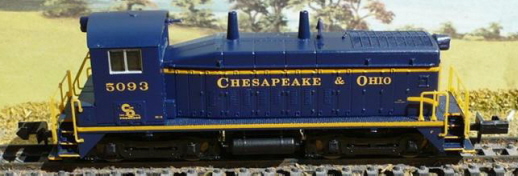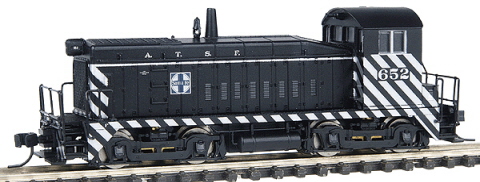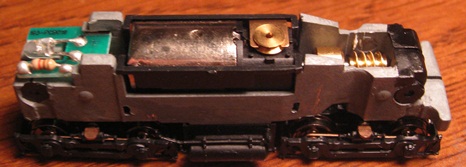



Introduced: 1997 (SW9/1200), 2003 (SW8/600/900), 2012 (revised SW9/1200) and 2017 (DCC-Ready SW9/1200)
Life-Like's 1997 SW9/1200 release was, by any measure, a watershed moment in N scale history. Up until that point, Life-Like was generally lumped in with the Bachmanns of the world as perveyors of cheap "trainset-style" motive power. But with this release, they firmly established their position as a player in the "high end" locomotive market (right up there with Atlas and Kato).
Sure, Life-Like has had their hits and misses since then. But they definitely hit a home-run in their first at-bat with the SW9/1200. It was, without question, the first really great yard switcher ever made for N-scale. And thanks to very minor external differences between EMD's various prototypes, these models can stand in for several different locomotives. The SW9 is externally the same as an SW1200, and the SW8 is externally the same as an SW900 or an SW600. The only physical differences between the two actual models (SW8 and SW9) are the exhaust stacks (with the SW9 having two and the SW8 having one).

The chassis is all-metal and split-frame. The motor is an open-sided / skew-wound 5-poler (with a single flywheel on the rear driveshaft). The wheels are blackened and all eight provide pickup (no traction tires). All four axles are geared. Prior to 2012, all gearing was plastic. After that, the worms were changed to brass. Directional lighting is provided by an LED-equipped PC board mounted to the front of the chassis (the light fixture on the cab-end is non-operational). An extra free-floating weight is mounted inside the cab to provide additional heft. Couplers are shell-mounted (Rapidos on the earlier runs, Accumates after that, and Micro-Trains on the most recent production runs). Coupler conversion is simple (pull out the clip, stick in your coupler of choice, put the clip back). Prior to the 2017 release there was no specific support for DCC on these models (although installing a wired decoder in the cab was a popular solution amongst the solder jockies).
Low-friction / axle-cup wipers transfer current from the trucks to flimsy/bendy metal contacts attached to the shell (which in turn transfer current to the chassis). IE, these things will not run at all unless the shell is on. Overall, kind of a strange system (and one that seems to annoy a lot of people). Although, having said that I can't really argue with the results as I've never had any problems with mine.
As noted above, the worms were changed from plastic to brass with the 2012 run of SW9's. In addition to the worm changes, the couplers were changed to Micro-Trains and the wheel flanges were downsized a bit (thus allowing them to operate on Code-55 rails). Walthers also decided to start calling these models "DCC Friendly" at this time (which only served to confuse everyone since the internal chassis/mechanism design remained entirely unchanged) -

A new DCC-Ready version of the Walthers SW9/1200 was released in 2017 (making use of the same internal modifications that Micro-Trains employed when they adapted the mechanism to their 2014 SW1500 models). The main difference here is that chassis current does not flow directly to the motor contacts. Rather, it first flows into the LED-equipped PC board (or decoder) on the front of the chassis. From there, wires plugged into the PC board (or decoder) conduct current to the insulated motor contacts. Digitrax's DN126M2 was the first decoder specifically designed for these models.

These models are gorgeous, and they run every bit as good as they look- smooth, responsive, quiet, great pickup, and slow speed creep in spades. Pretty much everything you'd want in a yard switcher. I guess my only real gripe here is with some of the detailing. The headlights and handrails are easily dislodged. And once lost, good luck ever finding them - they're beyond miniscule. My theory is that this is some sort of Machiavellian plot hatched by the Walthers parts department...
As for other peoples' problems, I have read that at least some of the pre-2012 models were delivered from the factory with faulty (out of round) plastic worms - and with the end result being a lot of noise. The reported solution is to simply replace the plastic worms with brass ones (Kato #926510's, for example) -

Another reported noise issue relates to the shell-mounted truck contacts. If incorrectly bent, they will cause the ride height of the chassis to be off relative to the trucks (thus interfering with the mesh between the worm and the worm gear). The solution here is to re-bend the chassis contacts such that they lightly touch the truck wipers without actually pushing down on them.
Trivia - shells from these models are reportedly a good fit for the Kato NW2 chassis.
Removing the shell from these models is somewhat arduous. In addition to the overall tight fit, the shell clings tenaciously to the chassis by way of eight different plastic clips (three on each side and one on each end). I still don't know if there's an "easy" way to go about this, but basically you need to free each of the clips and then gradually work the shell up and off. Be sure to take your time and be patient, these things are decidedly fragile.
Grade: A
Reviewed: 2/98 Model Railroader ("There's been somewhat of a dearth of N scale switchers on the market, but the folks at Life-Like are helping to rectify that by creating a wonderful locomotive that runs as well as it looks. The model can represent EMD's SW9 or SW1200, as both 1200-hp switchers shared the same body... The Life-Like shell is injection-molded styrene, and details on the shell are scale or as close as possible. I was especially impressed with the fine cross section of the plastic handrails. The cab has flush-fitting clear plastic window glazing and the pilots each have separate uncoupling levers. Speaking of the pilots, they are free of molded detail. Those who model roads that ran switchers with multiple-unit capability can add m.u. hoses... I compared the model... and found all the key dimensions were right on. All the samples I checked were neatly painted and lettered. The handrails are the appropriate color for each prototype...
"This is the best running N scale locomotive Life-Like has made. Considering this is a switcher, that's quite amazing. This model represents a new approach to N scale locomotive construction for Life-Like. It uses a vertically split frame, with the two electrically isolated halves each carrying power from one rail... The locomotive has a five-pole skew-wound motor with a small brass flywheel. The speed control was excellent... This locomotive can pull about 16 cars... All axles are powered and all wheels pick up electricity. All of the wheelsets on our samples were in gauge, but the flanges were a bit deeper than NMRA RP's... This is a good-looking, nice-running model. Its arrival means N scale no longer has to take a back seat to larger scales when it comes to yard operations. ATSF, ACL, BN, CS, C&NW, CMSP&P, Conrail, MP, PRR, Undec. Price: $65")